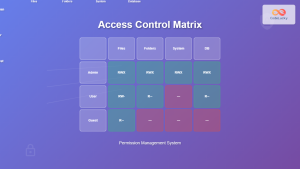In the world of database management, controlling access to data is paramount. The SQL REVOKE statement is a powerful tool that allows database administrators to remove previously granted permissions from users or roles. This article will dive deep into the intricacies of the REVOKE statement, exploring its syntax, use cases, and best practices.
Understanding the REVOKE Statement
The REVOKE statement is used to withdraw previously granted privileges from database users or roles. It's an essential component of database security, allowing administrators to fine-tune access control and ensure that users only have the permissions they need.
🔒 Key Point: REVOKE is the opposite of GRANT. While GRANT gives permissions, REVOKE takes them away.
Basic Syntax of REVOKE
The basic syntax of the REVOKE statement is as follows:
REVOKE privilege_type
ON object_name
FROM {user_name | role_name | PUBLIC};
Let's break down each component:
privilege_type: The type of permission being revoked (e.g., SELECT, INSERT, UPDATE, DELETE)object_name: The database object (e.g., table, view, procedure) from which the permission is being revokeduser_name | role_name | PUBLIC: The user, role, or all users (PUBLIC) from whom the permission is being revoked
Practical Examples of REVOKE
Let's explore some practical examples to understand how REVOKE works in different scenarios.
Example 1: Revoking SELECT Permission
Imagine we have a table called employees and we want to revoke the SELECT permission from a user named 'john_doe'.
REVOKE SELECT ON employees FROM john_doe;
This statement removes John Doe's ability to query the employees table.
Example 2: Revoking Multiple Permissions
We can revoke multiple permissions in a single REVOKE statement. Let's revoke INSERT and UPDATE permissions on the products table from a role called 'junior_staff'.
REVOKE INSERT, UPDATE ON products FROM junior_staff;
Now, users with the 'junior_staff' role can no longer insert new products or update existing ones.
Example 3: Revoking All Permissions
To revoke all permissions on a specific object, we can use the ALL PRIVILEGES clause:
REVOKE ALL PRIVILEGES ON customer_orders FROM sales_intern;
This statement removes all permissions that the 'sales_intern' user had on the customer_orders table.
Example 4: Revoking from PUBLIC
Sometimes, we need to revoke permissions from all users. We can do this using the PUBLIC keyword:
REVOKE SELECT ON sensitive_data FROM PUBLIC;
This statement ensures that no user has SELECT permission on the sensitive_data table by default.
CASCADE vs RESTRICT
When revoking permissions, you might encounter situations where the permission you're trying to revoke has been granted to other users or roles. In such cases, you can use the CASCADE or RESTRICT options.
🔗 CASCADE: Revokes the specified privileges from the user and from all other users to whom this user has granted these privileges.
🛑 RESTRICT: Prevents the revocation if the privilege has been granted to other users.
Example:
REVOKE SELECT ON financial_reports FROM manager CASCADE;
This statement revokes the SELECT permission on financial_reports from the 'manager' user and from any users to whom the manager had granted this permission.
Revoking Column-Level Permissions
Some database systems allow for column-level permissions. Here's how you might revoke permission to update a specific column:
REVOKE UPDATE (salary) ON employees FROM hr_assistant;
This statement revokes the permission to update the 'salary' column in the employees table from the 'hr_assistant' user.
Revoking GRANT OPTION
When a user is granted a permission WITH GRANT OPTION, they can grant that permission to other users. To revoke this ability, use the GRANT OPTION FOR clause:
REVOKE GRANT OPTION FOR SELECT ON customer_data FROM team_lead;
This removes the team lead's ability to grant SELECT permissions on the customer_data table to other users, but doesn't revoke their own SELECT permission.
Best Practices for Using REVOKE
-
Principle of Least Privilege: Only grant the minimum necessary permissions and revoke them when they're no longer needed.
-
Regular Audits: Periodically review and revoke unnecessary permissions to maintain tight security.
-
Use Roles: Instead of granting permissions to individual users, use roles. This makes it easier to manage permissions at scale.
-
Document Changes: Keep a log of all REVOKE operations for auditing purposes.
-
Test After Revoking: Always verify that the REVOKE statement had the intended effect by testing access afterwards.
Common Pitfalls and Troubleshooting
Revoking Non-existent Permissions
If you try to revoke a permission that wasn't granted, most databases will not throw an error. Instead, they'll complete the operation successfully without making any changes. This can lead to a false sense of security.
To avoid this, you can check existing permissions before revoking:
-- For PostgreSQL
SELECT grantee, privilege_type
FROM information_schema.role_table_grants
WHERE table_name='employees' AND grantee='john_doe';
-- For MySQL
SHOW GRANTS FOR 'john_doe'@'localhost';
Revoking System Permissions
Be cautious when revoking system-level permissions. Some operations might require elevated privileges, and revoking these can lead to unexpected behavior.
Revoking from Current User
Some database systems don't allow you to revoke permissions from the current user. Always ensure you're connected with the appropriate administrative account when performing REVOKE operations.
REVOKE in Different Database Systems
While the basic concept of REVOKE is similar across different database management systems, the exact syntax and available options can vary.
MySQL
In MySQL, the syntax is slightly different:
REVOKE privilege_type [(column_list)]
ON [object_type] privilege_level
FROM user_or_role [, user_or_role] ...
MySQL also supports revoking all privileges with a single statement:
REVOKE ALL PRIVILEGES, GRANT OPTION FROM 'john_doe'@'localhost';
PostgreSQL
PostgreSQL follows the standard SQL syntax closely but offers some additional options:
REVOKE [ GRANT OPTION FOR ]
{ { SELECT | INSERT | UPDATE | DELETE | TRUNCATE | REFERENCES | TRIGGER }
[, ...] | ALL [ PRIVILEGES ] }
ON { [ TABLE ] table_name [, ...]
| ALL TABLES IN SCHEMA schema_name [, ...] }
FROM { [ GROUP ] role_name | PUBLIC } [, ...]
[ CASCADE | RESTRICT ]
Oracle
Oracle's REVOKE syntax is similar to the standard:
REVOKE {privilege [, privilege] ... | ALL PRIVILEGES}
ON object
FROM {user [, user] ... | role | PUBLIC}
[CASCADE CONSTRAINTS | FORCE];
Conclusion
The SQL REVOKE statement is a crucial tool in maintaining database security and access control. By understanding its syntax and applications, database administrators can ensure that users have only the permissions they need, reducing the risk of unauthorized data access or modification.
Remember, effective use of REVOKE is not just about removing permissions—it's about maintaining a secure, well-organized database environment. Regular audits, careful documentation, and adherence to the principle of least privilege are key to leveraging REVOKE effectively.
As you continue to work with databases, you'll find that mastering REVOKE is an essential skill in your database administration toolkit. Practice using REVOKE in different scenarios, and you'll be well-equipped to manage database permissions with confidence and precision.



















